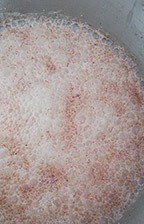Traditional Umqombothi
Traditional Umqombothi
(~2.5 gallons/10 L, all-grain)
ABV = ~2.5%
Recipes for umqombothi vary wildly. Some use double the amount of sorghum-to-maize, others use more maize than sorghum. Some start with a vast amount of liquid while others add the liquid in stages as the days progress. This recipe is based on one given to me by Nolu but with a few of my own tweaks that came about when I wasn’t sure what to do next and couldn’t get hold of my mentor. The recipe (with some added passion fruit) went on to win the homebrewing competition, which was judged by drinkers that were extremely familiar with the style.
Ingredients
8.8 lbs. (4 kg) malted sorghum
4.4 lbs. (2 kg) maize meal
Step by Step


Day one
Pour 2 gallons (8 L) of boiling water into a sanitized bucket, then add all of the maize meal and 4.4 lbs. (2 kg) of the malted sorghum to the water. Stir well to ensure there are no dough balls. Place a lid on the bucket for 10 minutes. After 10 minutes, add 1 gallon (4 L) of water. Mix again, then cover with cheesecloth or a tea towel and leave to cool overnight.

Day two
You should see lots of small bubbles rising to the surface of the mash. If you can’t, leave it for a few more hours. You will also note a decidedly sour aroma.
In a large pot, boil 1 gallon (4 L) of water. Once it reaches boiling point, add your sour mash, stirring constantly. Cook for one hour. Timing isn’t as important as you might be used to and you can start the timer from the moment the pot hits the stove — no need to wait until it reaches a boil. The mixture will darken as it cooks.
Stir occasionally to help stop it from sticking to the bottom of the pan, although some scorched grain is inevitable and an acceptable part of the process. After about an hour, return the mixture to your bucket and again leave it to cool overnight. You will find that the mixture is very thick, with little liquid.

Day three
Add the remaining 4.4 lbs. (2 kg) of malted sorghum to the cooled porridge. The mixture will be incredibly thick, with a consistency of mashed potatoes. Add a further 2 quarts (2 L) of cold water and stir. You want the mixture to reach a consistency of runny oatmeal. You might have to add up to 3 gallons (12 L) of extra water, depending on how much the porridge gelatinized during the boil.
Cover and leave in a warm place to ferment overnight.

Day four
You should see plenty of fermentation action, with bubbles rising to the surface throughout the day. If you have visible fermentation, you can strain the mixture and leave the wort to continue fermenting overnight. If fermentation is slow, leave it for another day, pushing the rest of the process back a day.

Day five
If you have strained your mixture, you should see a healthy kräusen atop your liquid, made up of large, cream-colored bubbles. This indicates that it is time to serve. Umqombothi is served uncarbonated and usually unchilled.
Written by Lucy Corne




